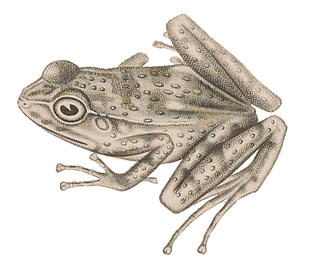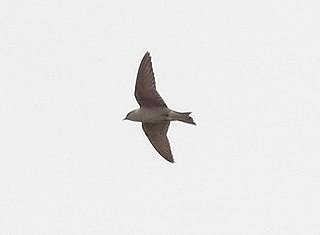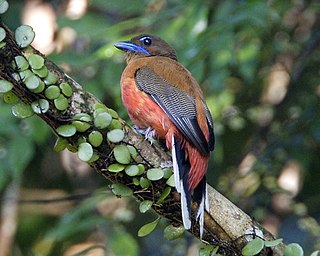
The long-billed partridge is a species of bird in the family Phasianidae.

Dendropsophus microps, the Nova Friburgo tree frog, is a species of frog in the family Hylidae. It is believed to be endemic to the Atlantic Forest of southern Brazil, but may occur in Argentina as well.

Ololygon argyreornatus, commonly known as the Rio Mutum snouted treefrog, is a species of frog in the family Hylidae endemic to Brazil. Its natural habitats are subtropical or tropical moist lowland forests, subtropical or tropical moist montane forests, subtropical or tropical moist shrubland, freshwater marshes, intermittent freshwater marshes, and heavily degraded former forests. It is threatened by habitat loss.
Ololygon luizotavioi is a species of frog in the family Hylidae. It is endemic to Brazil.

Ololygon machadoi is a species of frog in the family Hylidae. It is endemic to Brazil. Its natural habitats are subtropical or tropical moist lowland forests, subtropical or tropical moist montane forests, subtropical or tropical moist shrubland, and rivers. It is threatened by habitat loss.

The Uluguru forest tree frog or ruby-eyed tree frog is a species of frog in the family Arthroleptidae endemic to Tanzania. Its natural habitats are subtropical or tropical moist lowland forest, subtropical or tropical moist montane forest, rivers, and intermittent freshwater marshes. It is threatened by habitat loss.
Crossodactylus caramaschii is a species of frog in the family Hylodidae. It is endemic to Brazil.in São Paulo, Santa Catarina, and Paraná. Its natural habitats are subtropical or tropical moist lowland forest and rivers. It is threatened by habitat loss.

Crossodactylus dantei or the Murici spinythumb frog, is a species of frog in the family Hylodidae. It is endemic to Brazil. Scientists know it exclusively from the type locality: Murici, in Alagoas. Its natural habitats are subtropical or tropical moist lowland forest and rivers. It is threatened by habitat loss.
Crossodactylus dispar is a species of frog in the family Hylodidae. It is endemic to Brazil. Its natural habitats are subtropical or tropical moist lowland forest, subtropical or tropical moist montane forest, and rivers. It is threatened by habitat loss.

Crossodactylus gaudichaudii is a species of frog in the family Hylodidae. The species is endemic to Brazil.
Crossodactylus grandis, or the Bahia spinythumb frog, is a species of frog in the family Hylodidae. It is endemic to Brazil. Its natural habitats are subtropical or tropical high-altitude grassland and rivers. It is known solely from the Parque Nacional do Itatiaia in Minas Gerais in Brazil, where it lives in cloud forests. It is threatened by habitat loss.
Crossodactylus lutzorum is a species of frog in the family Hylodidae. It is endemic to Brazil. Scientists know it exclusively from the type locality: Fazenda Água Branca in Bahia. Its natural habitats are subtropical or tropical moist lowland forest and rivers. It is threatened by habitat loss.
Crossodactylus schmidti or Schmidt's spinythumb frog is a species of frog in the family Hylodidae. It is found in Argentina, Brazil, and Paraguay. Its natural habitats are subtropical or tropical moist lowland forest and rivers. People have seen it between 300 and 750 meters above sea level. It is threatened by habitat loss.

Eleutherodactylus dimidiatus is a rare species of frog in the family Eleutherodactylidae endemic to Cuba. Its natural habitats are subtropical or tropical moist lowland forest and subtropical or tropical moist montane forest. It is threatened by habitat loss.

Eleutherodactylus ionthus is a species of frog in the family Eleutherodactylidae endemic to Cuba. Its natural habitats are subtropical or tropical moist lowland forest and subtropical or tropical moist montane forest. It is threatened by habitat loss.
Ptychadena neumanni is a species of frog in the family Ptychadenidae. It is endemic to Ethiopia.

The Peruvian martin is a species of bird in the family Hirundinidae. It is found in Peru and far northern Chile.

Bedford's paradise flycatcher is a species of bird in the family Monarchidae. It is endemic to the Democratic Republic of the Congo.

The spotted ground thrush is a species of bird in the family Turdidae. It is found in the Democratic Republic of the Congo, Kenya, Malawi, South Africa, Sudan, Tanzania, and possibly Mozambique.

The scarlet-rumped trogon is a species of bird in the family Trogonidae. It is found in Brunei, Indonesia, Malaysia, Myanmar, and Thailand. Its natural habitats are subtropical or tropical moist lowland forest, subtropical or tropical swamps, and subtropical or tropical moist montane forest. It is threatened by habitat loss.













